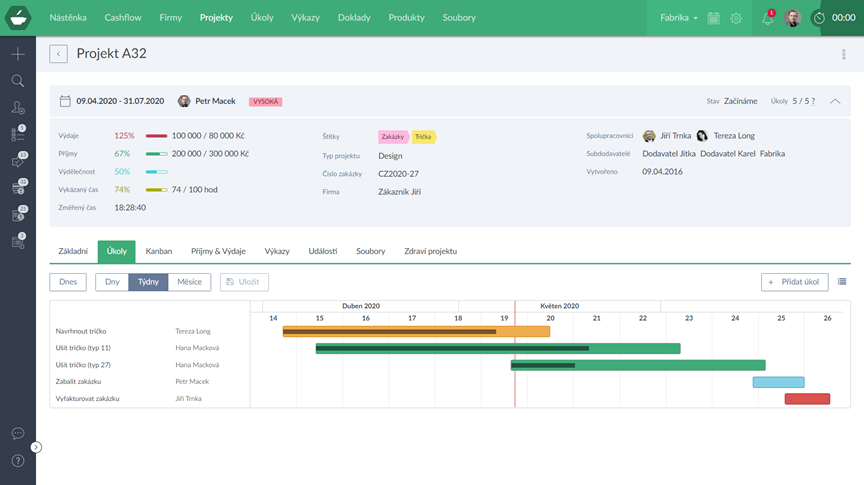If employees make a company, culture sustains it. A healthy work culture empowers your team members, encouraging them to work better and keeping them happy.
Good managers have done a great job at building positive, lasting work cultures. They’ve got their own playbooks for motivating team members, building bonds, and protecting the workplace from toxicity.
However, remote work options have shaken the cultural landscape up. Whereas many managers are skilled at cultivating the right office culture, some struggle to achieve the same outcomes in remote environments.
🎓 The Caflou series “How to manage a company and a team remotely” is brought to you by CAFLOU® – business management system which is used to manage the performance and economy of your company, team and projects, 100% digitally, even remotely.
So why is the playbook for building culture in a remote team different? And how can managers overcome challenges to build a positive remote team culture?
These are questions we’ll answer in this article.
What is remote work culture?
Remote work culture is the digital culture in your organisation that encourages employees to engage, collaborate, and achieve company goals. A strong remote work culture instils a sense of purpose and responsibility in your workforce, cultivating a positive environment for growth.
Why is culture important for remote teams?
Culture is important for remote teams for the same reasons it is vital for in-office teams; a strong culture can increase productivity and work quality and reduce attrition rates and burnout (source).
However, although organisational leaders have successfully implemented workplace cultures that drive employee engagement, their methods rely heavily on face-to-face interaction. Unfortunately, these strategies do not scale well in the digital landscape.
So, managers and organisational leaders need to explore new ways to cultivate and sustain a strong remote work culture. We need new systems in place to help remote teams thrive.
A growing body of research suggests a strong relationship between employee engagement and performance. Organisational leaders believe that employees better contribute to their company when they are more engaged - when they feel like the customer.
But, ‘engagement’ is difficult to define and measure. There are, however, established theories that reveal possible relationships between employee engagement, including correlations with factors like psychological safety and meaningfulness.
And while we won’t explore these theories in-depth, we will discuss the best practices for building culture in your remote team.
How to build culture in your remote team
Define your remote team culture
Before you can work towards establishing a remote work culture, it’s crucial to define the culture itself. What values, principles, and workplace practices will benefit your team or workforce?
Your team’s culture includes their broad personal characteristics and work ethic/behaviour. For example, you might define ‘self-starter’ as a valuable trait for your team members. Conversely, your remote work culture might also include standards for communication that must be met.
So when you define your remote team’s culture, it’s important to consider:
- Values you’d like to instil in your team members as individuals.
- Values you’d like to instil in your team; i.e., traits that influence your team’s collective function.
- Expectations for workplace communication and collaboration; these factors are crucial drivers of employee engagement.
Enhance your onboarding experience
An effective onboarding experience makes employees feel more included and connected to your organisation. This can help them better integrate with your team and encourages engagement.
However, many organisations still lag behind in providing the right onboarding experience for new hires; companies aren’t taking the necessary steps to help employees integrate with the company culture.
Thus, HR and team leaders should create customised onboarding experiences to help new hires learn about the company culture and integrate with their new team. In our age of advanced Learning Management Systems (LMS) and team management tools, creating self-service onboarding experiences is significantly easy.
You can create video walkthroughs and relevant documentation to help new hires quickly integrate. Moreover, team managers should organise meetings for new hires with existing team members to facilitate swift team building.
Onboarding experiences do not need to be extensive or complex. But they should be relevant and engaging.

Set standards for communication and collaboration
Successful communication and collaboration are essential for teams to function effectively, but managers shouldn’t rely on team members to set standards for engagement.
Instead, remote team managers and leaders should assess each team’s structure and workflow and set appropriate standards for communication and collaboration. Some team members may need to meet more frequently due to the requirements of their role, relative to others.
Moreover, managers should also guide team members to guarantee meetings are productive and beneficial. For example, you might want to consider:
- Cautioning team members against holding long meetings.
- Advising team members to set meeting agendas to ensure they are productive.
- Encouraging employees to end each meeting with defined ‘action tasks’ - so each team member knows what they should take from the meeting.
Foster a culture of trust, psychological safety, and mutual respect
Google conducted an initiative, Project Aristotle, to better understand what makes a high-performing team. The tech giant discovered that the secret was psychological safety - a crucial element of team culture.
Building psychological safety involves creating a culture that values each employee’s thoughts, feelings, and opinions. Each team member should feel that their valuable input is being well-received.
For this culture of trust and mutual respect to exist, team leaders and managers must commit to incorporating these values. After leadership embraces psychological safety and commits to making employees feel valued and safe, team members will follow suit.
Work team building activities into the calendar
Team building activities are a crucial driver for building team culture, but this is another area that organisational leaders struggle to scale in the digital landscape. Our best advice for incorporating team building activities is to get your team members involved.
You can start by suggesting different ideas and asking them to share theirs. Then, you can try different tasks out and collect feedback to determine which ones are effective. For example, you might find that work-focused team building activities are more effective than, say, casual virtual lunch sessions.
Make collaboration easy with the right tech
Remote teams exist on digital infrastructure. So, growing your team and cultivating team culture becomes an even greater challenge if your infrastructure is weak or disorganised.
That’s why it’s crucial to leverage the right tech stack - and your ideal stack depends on your team’s needs. Some teams require more platform-rich features, while others may have more modest needs, favouring a simpler solution.
When choosing your remote team collaboration tech stack, here are some important factors to consider:
- Your team’s everyday needs. What tools do they need to communicate? How can they collaborate on projects?
- Administrative needs. Do you need tools for expense management? Does your team need client portals and software for managing customers?
- Occasional needs. Such as specific tools your team might need for seasonal campaigns or one-off events.
- Operational efficiency. If you go all-out on your tech stack and choose multiple software with steep learning curves, you might overwhelm your team. Having to switch through multiple tools can hurt their workflow and makes it difficult for you to onboard new hires.
Because of this last point, many team leaders find integrated solutions like CAFLOU helpful. The advantage of an integrated business process management tool is that many of your core operations are managed in a single platform, streamlining workflows and providing managers with a more unified view.
Don't neglect physical meet-ups
While remote team-building activities can help your team members get to know each other, they are no replacement for physical meet-ups. If your team is geographically distributed, meet-ups might be difficult.
But if team members are in close vicinity, it’s important to schedule occasional physical meet-ups. They’ll help your team members get to know each other better and connect more fundamentally, helping them work together more effectively.
Provide equal experiences
If your workforce is hybrid, your in-office employees might get special perks like lunch allowances, gym memberships, development opportunities, etc. If your in-office employees receive these perks, it’s important to make sure that your remote teams do, too.
Moreover, if your company hosts scheduled events or networking opportunities, consider allocating a travel allowance for your remote employees. Providing team members with development opportunities helps increase employee satisfaction and encourage loyalty.
So make sure your hybrid teams receive equal experiences.
How to sustain a positive remote team culture
After laying the foundation for a strong remote team culture, it’s crucial to sustain your efforts. You’ll need to implement systems of quality assurance to make sure your team culture continues to grow positively.
Reevaluate your talent sourcing
Who you hire directly affects your remote team culture. If you hire employees who are the right cultural fit - or those who can contribute positively to your existing culture - you’re in the clear.
However, if your talent sourcing efforts invite employees that can’t integrate with your organisation, your team’s culture will be at risk. An unfit employee can hurt team productivity and disrupt the positive culture that exists.
So, it’s crucial to reevaluate your talent sourcing efforts. Make sure HR leaders and your talent acquisition specialists are nurturing their talent pools to your company’s needs. And if you identify issues in talent sourcing, encourage HR teams to change tact.
Regularly analyse your setup and collect feedback
No systems are perfect. Even after your remote teams are functional and the team culture seems smooth, it’s important for managers to continuously collect feedback and keep an eye out for inefficiencies.
Your analysis might reveal unexpected problems or even new ones. For example, new hires could disrupt your team culture - or an employee leaving can cause a similar outcome.
If you’ve set the right team culture up, your team will naturally cultivate and contribute to it. But team leaders should still monitor the setup and intervene where necessary.

Protect what you’ve built
Toxic employees can damage your remote team culture and discourage other team members from performing. If you keep toxic employees around, they will gradually poison your work culture at an organisational level, inviting dire consequences.
A study by Harvard Business Review found that toxic employees can cost organisations an extra $12,500. The study revealed that avoiding a toxic hire can be more profitable for your organisation than hiring an exceptional employee - a superstar.
Thus, managers should look for toxic patterns and prevent toxic employees from poisoning the workplace. If an employee is found to be toxic, organisational leaders should take necessary regulatory action to protect the overall team culture.
Don’t forget what’s important
Culture starts with people, scales with relationships, and is safeguarded by managers. So as you build and grow your team, don’t forget that your remote team culture is built on maintaining meaningful relationships with your employees.
<< Back to all articles in the series How to manage a company and a team remotely